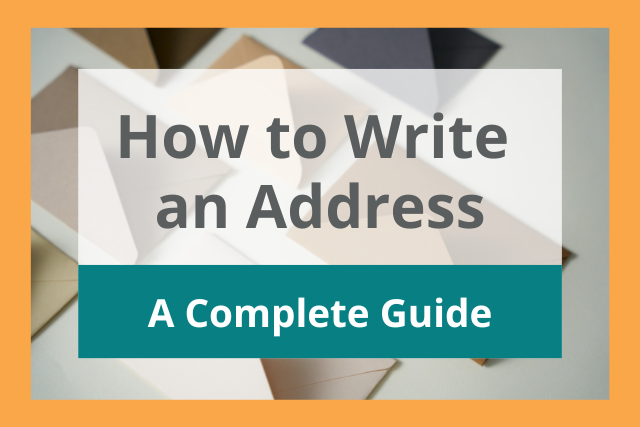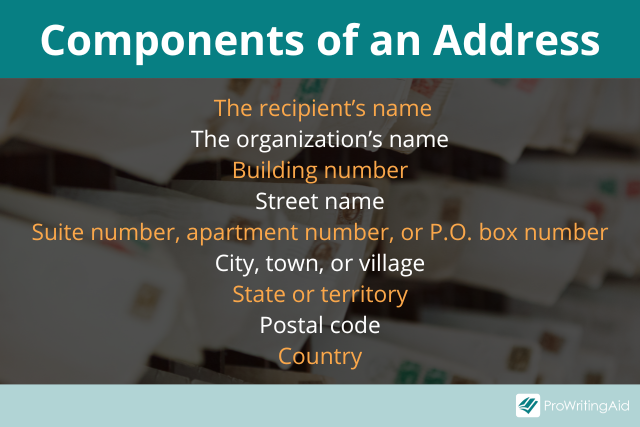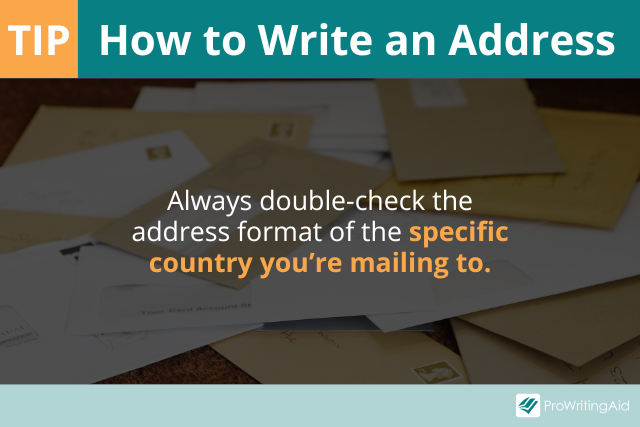
Whenever you mail a letter, you need to write the address correctly. If you format the address incorrectly, your mail might get delivered to the wrong destination.
That’s just one situation in which you’ll need to know how to write an address. You may also need to write your address in the header of a resume, to fill out legal forms, and countless other situations.
If you’re trying to write an address, you’ve come to the right place. This article will give you a complete guide to formatting an address and provide examples of common address formats.
What Is an Address?
An address consists of all the information that a mail carrier needs to identify a location.
Addresses contain some or all of the following pieces of information:
- The recipient’s name
- The organization’s name, if necessary
- Building number
- Street name
- Suite number, apartment number, or P.O. box number, if necessary
- City, town, or village
- State or territory
- Postal code
- Country
It’s important to include all the information that the post office needs to identify the correct location, without including any extraneous information. If you add any extraneous lines or words, it will be harder for others to figure out what the actual address is.

What Are the Address Formats for Mailing a Letter?
When you mail a letter in the US, you’ll need to include both the recipient’s address and the sender’s address. Let’s look at how to format each one.
Mailing Address Format
Whenever you mail a letter, you need to put the recipient’s address at the center of the envelope. This is where the postal courier will look to figure out where to deliver the letter to.
If you’re writing to a recipient in the US, you should include the following pieces of information, in this order:
- The recipient’s name on the first line. You can choose whether or not to include a title, such as Ms. or Dr.
- The recipient’s building number and street name. Also include a suite number, apartment number, or P.O. box number on the second line, if necessary
- The recipient's city, state, and postal code on the final line
The address should consist of three lines of text, one for each of the bullet points above.
You only need to include a suite or apartment number if you live in a building where multiple individuals or families share the same building number. That way, couriers can figure out which specific apartment to deliver the mail to.
When you write the postal code, you can write out either the five-digit ZIP code (e.g. 98052), or the five-digit ZIP code with the area-specific four-digit suffix (e.g. 98052-1134). Including your full postal code will help couriers deliver your package more quickly.
Return Address Format
The term “return address” refers to the address of the person sending a letter or package. The reason you need to include your own address on any letter or package you send is so the postal service knows where to return the mail if they’re unable to deliver it. You should place your return address on the upper left corner of the envelope.
If you live in the US, you should include the following pieces of information, in this order:
- Your name on the first line. You can choose whether or not to include a title, such as Ms. or Dr.
- Your building number and street name. Also include a suite number, apartment number, or P.O. box number on the second line, if necessary
- Your city, state, and postal code on the final line
Just like with the mailing address, the return address should be three lines of text, one for each of the bullet points above.
What Are the Address Formats for Specific Types of Addresses?
The guidelines to follow when writing an address often depends on the specific type of letter you’re writing. For example, if you’re sending an international letter to a country outside of the US, you may need to format your address differently.
Let’s look at some of these specific guidelines.
Business Address Format
When you’re sending mail to a business address, you may need to include some additional information that you wouldn’t include for a personal letter.
That’s because the courier may need to know the company name, as well as the name of the specific person within the company you’re writing to.
Here’s the information you need to include in a business address:
- The recipient’s name. You can precede this name with the word Attention or ATTN, followed by a colon. You can choose whether you want to include any relevant professional titles, such as Ph.D. or Esq.
- The name of the recipient’s company or organization
- The company’s building number and street name
- The company’s floor or suite number, if necessary
- The company’s city, state, and postal code
International Address Format
If you’re mailing a letter outside of the US, you’ll need to adhere to the format of the country you’re sending the letter to. That way, the postal service within that country will know where to go.
In general, these are the pieces of information you should include in an international address:
- The recipient’s name
- The name of the recipient’s house, if their home has a specific name
- The recipient’s building number and street name, if their house does not have a specific name
- The recipient’s city, town, or village
- The recipient’s county
- The recipient’s postal code
- The recipient’s district, if necessary
- The recipient’s country
To be safe, you should always double-check the address format of the specific country you’re mailing to.

When you write your return address on international mail, you should format it the same way you usually would. In addition, you should include your own country at the bottom of the return address.
Resume Address Format
When you write a professional resume, you should include your address at the top of your resume. You can either include it in your header or add it in the top left corner.
The good news is that you should use the same format for writing an address in a resume that you would use for writing a letter. Include all the same information you would use for a return address.
One-Line Address Format
Sometimes, you may need to write an entire address in a single line of text.
In this case, you should include all the same information that you would include in a multi-line address. The only difference is that you’ll need to replace each line break with a comma when you write an address on one line.
Make sure to include a comma after each of these elements:
- The person’s name
- The street address
- The apartment number or suite
- The city
Should You Use Abbreviations in an Address?
It’s perfectly acceptable to use abbreviations when writing an address—in fact, it’s often expected.
Here are some common abbreviations you should know:
- Apartment: Apt
- Boulevard: Blvd
- Drive: Dr
- Lane: Ln
- Parkway: Pkwy
- Road: Rd
- Street: St
- Suite: Ste
- North: N
- South: S
- East: E
- West: W
You should also abbreviate all the US states with a two-letter code. For example, you would write CA for California or DE for Delaware.
Address Examples
To help you understand what a correctly formatted address should look like, we’ve included some examples you can refer to.
US Address Examples
Here’s an example of a domestic residential address in the US:
John Smith
5480 7th Ave
San Francisco, CA 94112
Here’s an example of a US address with an apartment number:
Ms. Mary Green
2211 Edgewood St, Apt 2
Boston, MA 02124-1331
One-Line Address Examples
Here’s how you would write each of the above addresses on a single line:
John Smith, 5480 7th Ave, San Francisco, CA 94112
Ms. Mary Green, 2211 Edgewood St, Apt 2, Boston, MA, 02124-1331
Professional Address Examples
If you’re writing a business letter, don’t forget to include the organization’s name. Here’s an example:
Attn: Rachel Long, CEO
The Greatest Writers’ Organization
780 English Avenue, Floor 8
Seattle, WA 90199
International Address Examples
Here’s an example of an address in Canada:
Jacob White
423 Second Street NE
Montreal, QC H3Z 2Y7
Canada
(In this case, Montreal is the city, QC is the province, and H3Z 2Y7 is the postal code.)
Here’s an example of an address in Great Britain:
Harry Brown
87 Blackstone Street
London
EC1Y 8SY
England
(In this case, London is the city, and EC17 8SY is the postal code.)
Conclusion on How to Write an Address
There you have it—a complete guide to writing an address correctly! Here’s a quick recap:
- An address should include everything a mail carrier needs to identify the recipient’s location
- It’s expected that you’ll use standard abbreviations, such as St for Street
- The guidelines may be different for international addresses, so always double-check each country’s guidelines
Lastly, make sure you write your address in clear and legible handwriting, so your mail can be delivered efficiently.

